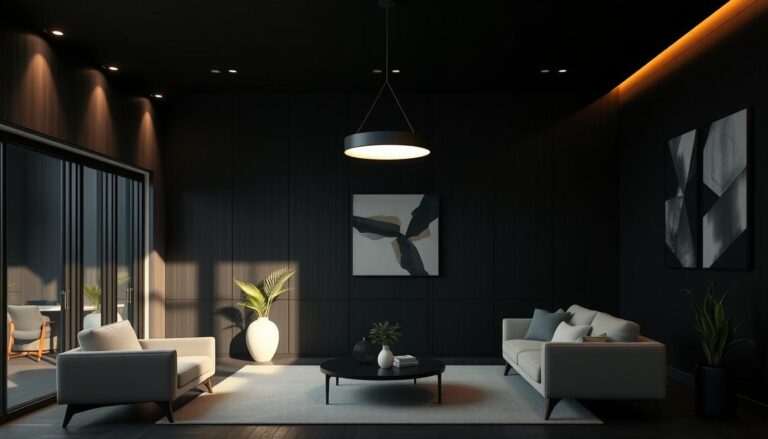A gallery wall is a great way to infuse some texture and pattern into your space and tell a personal story. By curating a collection of meaningful items, you can create a unique and personalized gallery wall decor that reflects your personality and style.
Visual storytelling is an essential aspect of home decor, and a gallery wall is an effective way to display memories and personal items. By incorporating gallery wall inspiration into your design, you can create a visually appealing display that showcases your story.
Key Takeaways
- Gallery walls can add texture and pattern to a room.
- Personalized gallery wall decor can reflect your personality and style.
- Storytelling through gallery walls is a unique way to display memories.
- A well-designed gallery wall can make a room more visually interesting.
- Gallery wall inspiration can help you create a unique display.
The Power of Visual Storytelling in Home Decor
Gallery walls have transcended mere decoration, evolving into a dynamic form of visual storytelling that reflects our individuality. This transformation is rooted in the human desire to connect with our surroundings on a deeper level.
Why Gallery Walls Have Enduring Appeal
Gallery walls continue to captivate homeowners because they offer a unique way to display memories and tell personal stories. Unlike other decorative elements, gallery walls are highly customizable, allowing individuals to curate a visual narrative that resonates with their experiences and emotions.
How Personal Narratives Transform Spaces
By incorporating personal artifacts and meaningful images, gallery walls transform living spaces into reflective narratives of our lives. This transformation not only personalizes a home but also creates a sense of warmth and character that generic decor cannot achieve.
The Psychology of Surrounding Yourself with Meaningful Images
Surrounding ourselves with meaningful images has a profound psychological impact. It fosters a sense of identity and belonging, as the images and artifacts displayed on a gallery wall serve as tangible connections to our memories and experiences.
In conclusion, the power of visual storytelling through gallery walls lies in their ability to weave together personal narratives, creating a unique and captivating form of home decor that is both aesthetically pleasing and emotionally resonant.
Planning Your Gallery Wall Narrative
Before you begin arranging your gallery wall, it’s essential to define the story you want to tell. A gallery wall is more than just a collection of frames; it’s a visual representation of your experiences, memories, and personality.
Identifying Your Story’s Theme
To start, identify the theme that will tie your gallery wall together. This could be based on various aspects of your life.
Family History Displays
Creating a gallery wall around your family history can be a meaningful way to showcase your heritage. Include photos of ancestors, heirlooms, or other significant family artifacts.
Travel and Adventure Collections
If you’re an avid traveler, consider curating a gallery wall that highlights your adventures. Use maps, postcards, or photographs from your trips to create a visually appealing display.
Personal Growth Timelines
A gallery wall can also serve as a timeline of your personal growth. Include photos, quotes, or mementos that represent significant milestones in your life.
Determining the Emotional Impact You Want to Create
The emotional impact of your gallery wall depends on the story you’re telling. Consider what emotions you want to evoke in those who view your gallery wall.
To achieve the desired emotional impact, choose items that resonate with your theme and arrange them in a way that creates a cohesive narrative.
Mapping Your Wall’s Journey
Once you’ve identified your theme and the emotional impact you want to create, it’s time to map out your wall’s journey. Start by selecting a dominant piece to anchor your gallery wall.
Use a mix of frame styles and sizes to add visual interest. Consider creating a digital mockup of your gallery wall to experiment with different layouts before committing to a final arrangement.

By following these steps, you can create a gallery wall that not only tells your story but also engages and inspires those who see it.
Curating Items That Tell Your Story
Curating a gallery wall involves selecting items that resonate with your personal story, making it a unique reflection of who you are. It’s about creating a visual narrative that not only decorates your space but also speaks to your experiences, memories, and passions.
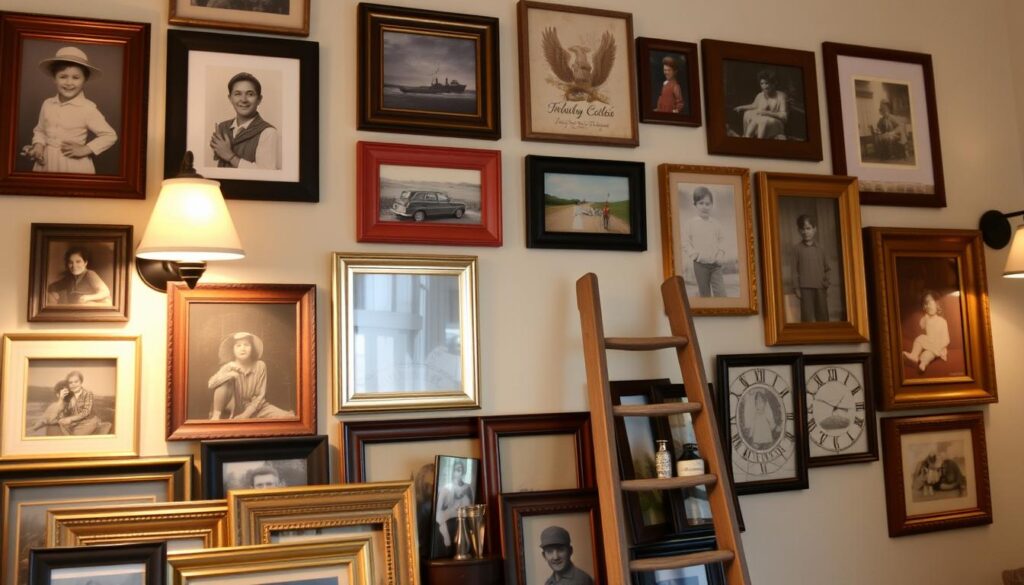
Beyond Photos: Incorporating Meaningful Objects
While photos are a staple in many gallery walls, incorporating other meaningful objects can add depth and interest. Consider including personal artifacts like vintage postcards, antique jewelry, or other unique collectibles that hold sentimental value.
These items can serve as conversation starters and add layers to your narrative. For instance, a vintage map can highlight your love for travel, while a piece of antique jewelry can symbolize a cherished family heirloom.
Mixing Personal Artifacts with Purchased Art
Blending personal artifacts with purchased art can create a visually appealing and dynamic gallery wall. Purchased art can include prints from local artists, abstract paintings, or other forms of visual art that resonate with your personal style.
The key is to find a common thread that ties all the pieces together, whether it’s a color scheme, a particular theme, or a mix of frame styles. This blend of personal and purchased items can make your gallery wall truly unique and personalized.
Creating Balance Between Sentiment and Style
One of the challenges in curating a gallery wall is striking a balance between sentiment and style. While it’s essential to include items that hold emotional significance, it’s equally important to ensure that the overall display is aesthetically pleasing.
To achieve this balance, consider the visual elements of each piece, such as color, texture, and frame style. By mixing different textures and frame styles, you can add visual interest to your gallery wall while maintaining a cohesive look.
Sourcing Unique Pieces That Enhance Your Narrative
To make your gallery wall truly special, look for unique pieces that enhance your narrative. This could include limited edition prints, original artwork, or other one-of-a-kind items that reflect your personality and interests.
Thrift stores, art fairs, and online marketplaces can be great sources for unique pieces. By incorporating these items into your gallery wall, you can create a display that is not only visually appealing but also tells a compelling story about who you are.
How to Create a Gallery Wall That Tells Your Story
To create a gallery wall that resonates with your personal narrative, you need to start with a clear vision. This involves understanding the story you want to tell and the emotions you want to evoke in those who see it.
Selecting a Wall That Enhances Your Narrative
The first step is to choose a wall that complements your story. Consider the room’s purpose and the wall’s visibility. A wall in a high-traffic area like a living room or hallway is ideal for a gallery wall.
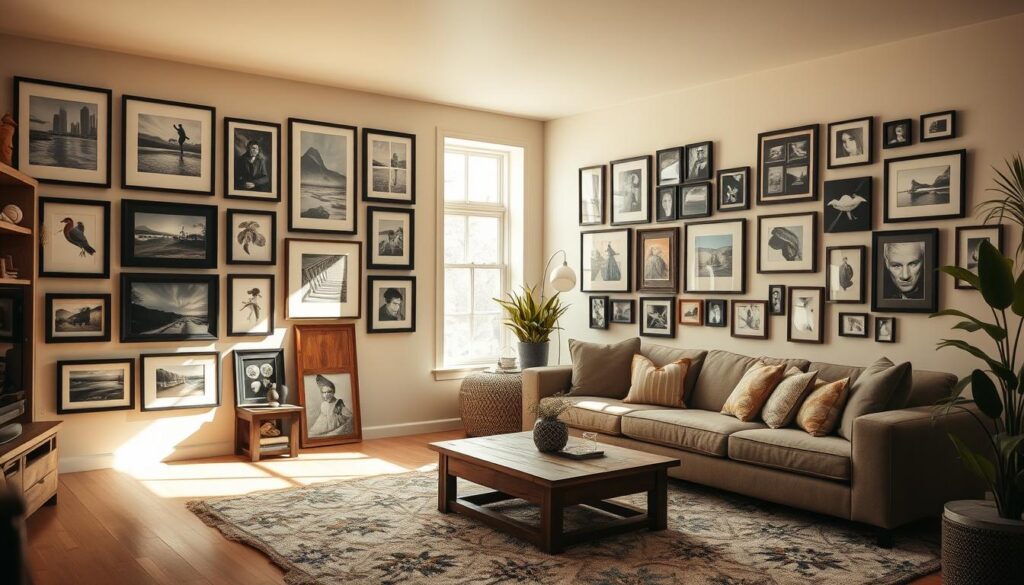
Determining Scale and Proportion
Scale and proportion are crucial for a visually appealing gallery wall. Larger pieces can be anchors, while smaller ones fill in the gaps. Ensure the overall arrangement is balanced and harmonious.
Creating Visual Flow That Guides Viewers Through Your Story
Visual flow is essential for guiding viewers through your narrative. Arrange pieces in a way that leads the eye naturally from one item to the next, creating a cohesive story.
Incorporating Negative Space for Impact
Negative space is just as important as the items on your wall. It helps to create a clean and uncluttered display, allowing each piece to stand out and contribute to the overall narrative.
By carefully selecting the right wall, determining the appropriate scale and proportion, creating a visual flow, and incorporating negative space, you can create a gallery wall that effectively tells your story.
Design Principles for Cohesive Gallery Walls
To create a visually appealing gallery wall, one must consider several key design principles. A well-designed gallery wall can be achieved by applying principles like color theory, rhythm, and balance. This approach ensures that the gallery wall not only looks great but also effectively tells a story.
Color Theory for Storytelling Displays
Color theory plays a crucial role in creating a cohesive gallery wall. By selecting a color scheme that complements the narrative, you can enhance the overall impact of the display.
Monochromatic Approaches
A monochromatic color scheme involves using different shades of the same color. This approach can create a sense of harmony and cohesion, making it ideal for telling a story through a gallery wall.
Complementary Color Schemes
Complementary colors are pairs of colors that are opposite each other on the color wheel. Using complementary colors can add contrast and visual interest to your gallery wall, making it more engaging.
Creating Rhythm and Movement
Rhythm and movement in a gallery wall can be achieved by varying the size and orientation of the frames, as well as the spacing between them. This creates a dynamic visual experience that guides the viewer’s eye through the story.
For example, you can create a sense of movement by alternating between large and small frames or by using frames with different orientations.
Balancing Uniformity and Variety
A balanced gallery wall strikes a harmony between uniformity and variety. While uniformity can create a sense of cohesion, too much can make the display look monotonous. Introducing variety through different frame styles, sizes, and shapes can add visual interest.
- Mixing frame styles, such as modern and vintage, can add depth to your gallery wall.
- Using a variety of frame sizes and shapes can create a dynamic and engaging display.
Typography and Text Elements in Gallery Walls
Incorporating typography and text elements can enhance the narrative of your gallery wall. Quotes, lyrics, or personal messages can add an extra layer of meaning to the display.
When incorporating text elements, consider the font style, size, and color to ensure they complement the overall aesthetic.
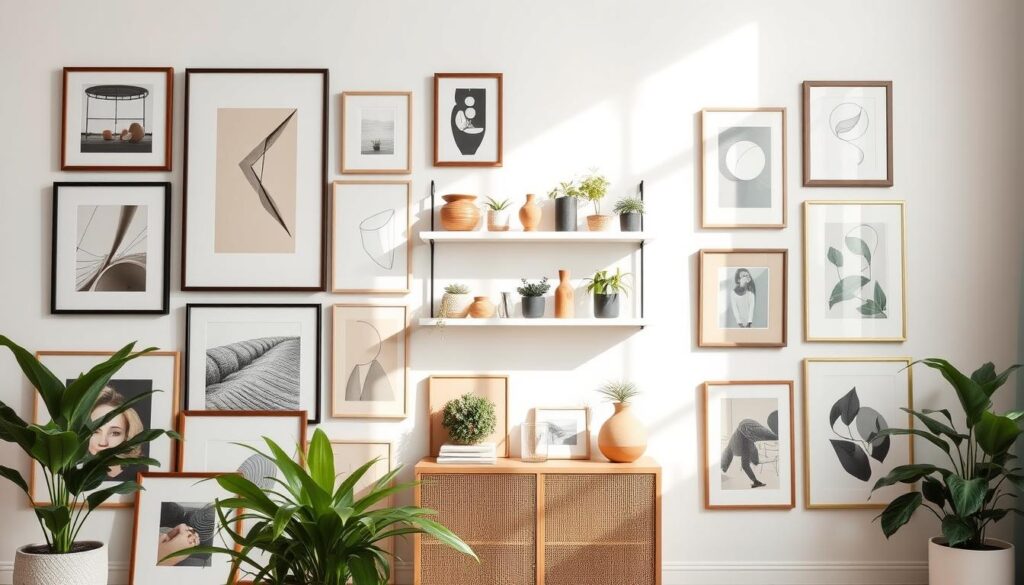
By applying these design principles, you can create a cohesive and visually appealing gallery wall that effectively tells your story. Whether you’re incorporating personal artifacts or purchased art, a well-designed gallery wall can transform any room into a meaningful space.
Creative Ways to Design a Gallery Wall
Gallery walls offer a unique opportunity to showcase your story through a curated collection of images and objects. By thoughtfully selecting and arranging the pieces, you can create a visually appealing display that adds character to any room.
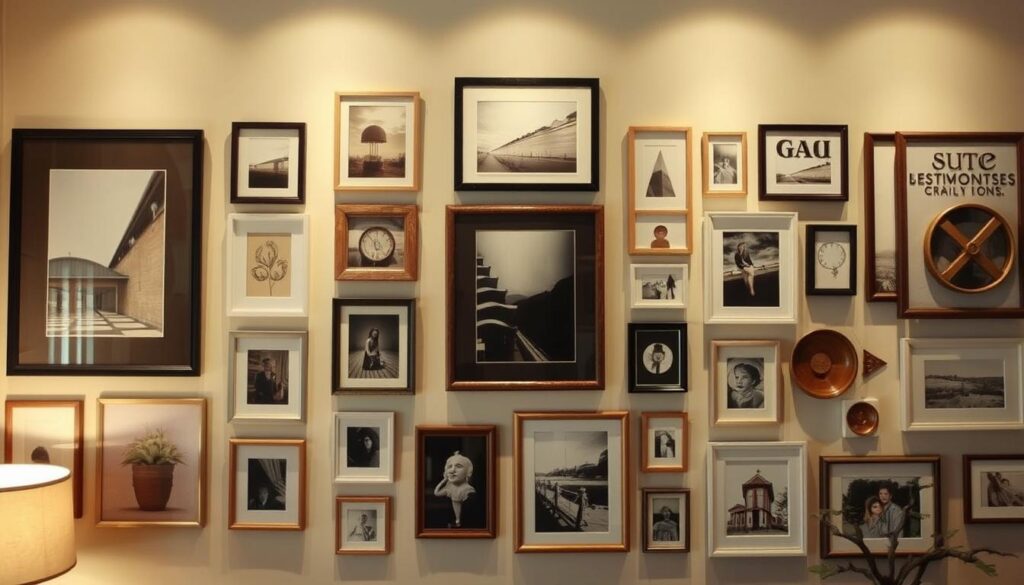
Symmetrical vs. Asymmetrical Layouts
When designing a gallery wall, one of the first decisions you’ll need to make is whether to opt for a symmetrical or asymmetrical layout. Symmetrical arrangements offer a sense of order and calm, while asymmetrical layouts can create a more dynamic and interesting visual experience.
Symmetrical layouts work well in traditional or formal spaces, whereas asymmetrical layouts are often more suited to modern or eclectic decor.
Salon-Style Arrangements
Salon-style arrangements are a popular choice for gallery walls, characterized by a dense, layered look that creates a sense of depth and visual interest. This style is ideal for those who want to showcase a large collection of pieces.
To achieve a salon-style arrangement, start by grouping your frames together on the floor to get a sense of the overall composition, then hang them on the wall, working from the center outwards.
Grid Patterns and Their Impact
Grid patterns offer a clean and structured approach to gallery wall design. By arranging frames in a grid, you can create a sense of unity and cohesion, making it easier to view individual pieces within the larger composition.
Grid patterns work particularly well in modern or minimalist spaces, where a sense of simplicity and order is desired.
Unique Gallery Wall Layouts for Different Spaces
The layout of your gallery wall should be influenced by the specific space in which it will be displayed. For example, a narrow hallway might benefit from a vertical, stacked arrangement, while a large living room wall might accommodate a more sprawling, asymmetrical design.
Consider the room’s architecture, furniture, and overall aesthetic when deciding on a layout, and don’t be afraid to experiment until you find a configuration that feels just right.
Frame Selection and Matting Techniques
Selecting the perfect frames and matting is a crucial step in crafting a gallery wall that resonates with your personal style. The right frames and matting can enhance your gallery wall, while also providing an opportunity to add personal touches.
Choosing Frames That Complement Your Narrative
The frame you choose for each piece can significantly impact the overall narrative of your gallery wall. For instance, a modern, minimalist frame can give your display a sleek, contemporary look, while an ornate, vintage frame can add a touch of elegance and sophistication.
Consider the style and era of the items you’re framing. For a cohesive look, you might choose frames that share a common design element, such as a similar color or material. Mixing frame styles can add visual interest, but be sure to balance them to avoid a chaotic appearance.
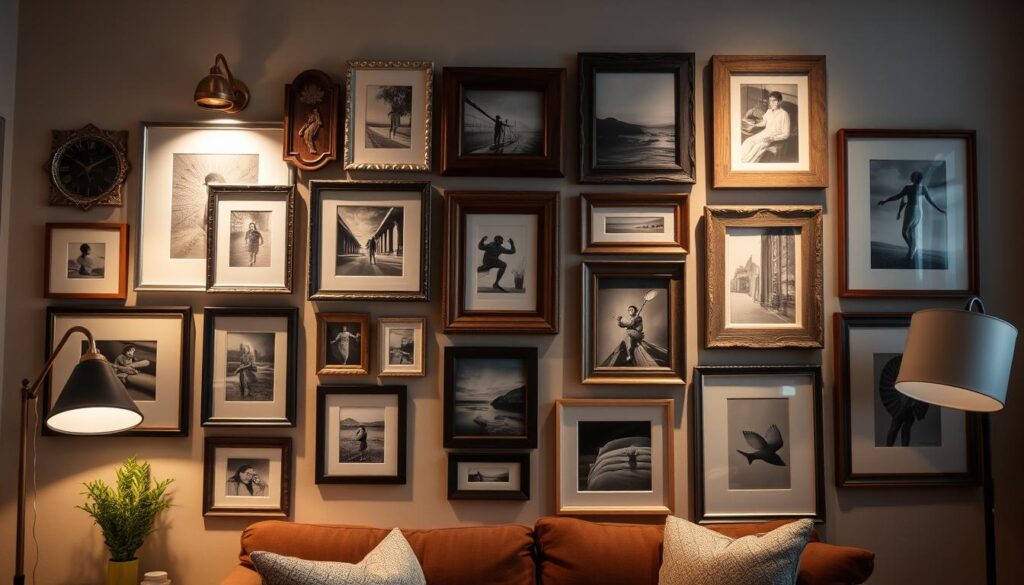
Strategic Use of Matting to Highlight Key Pieces
Matting can serve both aesthetic and practical purposes. It can help to separate the artwork from the glass, preventing it from touching and potentially damaging the piece. Matting can also be used to create a visual break between the frame and the artwork, drawing the viewer’s eye to the content.
When choosing matting, consider the colors present in your artwork or photographs. A well-chosen mat color can enhance the piece and tie it to other elements in your gallery wall. For example, a white or cream mat can provide a clean, crisp contrast to darker frames or artwork.
When to Splurge vs. When to Save on Framing
Deciding when to invest in high-quality framing and when to opt for more budget-friendly options depends on the significance and longevity of the piece. For heirloom-quality items or particularly meaningful pieces, it’s worth investing in high-quality frames that will protect and showcase them effectively.
| Framing Element | Splurge | Save |
|---|---|---|
| Frame Material | High-quality wood or metal | Engineered wood or simpler metal frames |
| Matting | Acid-free, archival quality | Standard matting options |
| Glass/Acrylic | UV-protective glass | Standard glass or acrylic |
DIY Framing Options for Budget-Conscious Decorators
For those on a budget, DIY framing can be a cost-effective way to achieve a high-end look. Consider repurposing or upcycling old frames, or using unconventional materials to create unique frames that add to your gallery wall’s narrative.
As emphasized by interior design expert,
“Framing is not just about putting a picture in a frame; it’s about creating a visual experience that tells a story.”
By thoughtfully selecting frames and matting, you can elevate your gallery wall and create a truly personalized display.
Tips for a Curated Gallery Wall Installation
A gallery wall is more than just a collection of frames; it’s a curated story that enhances your living space. To bring this narrative to life, careful planning and precise execution are essential.
Creating Templates Before Hanging
Before you start hammering nails, create a template of your gallery wall on the floor or use a digital tool to visualize the arrangement. This step ensures that you’re satisfied with the layout and makes the hanging process smoother.
Tools and Hardware for Secure Installation
Invest in quality hanging hardware to secure your gallery wall. Use a level, a pencil, and a measuring tape to ensure everything is straight and evenly spaced. For heavier pieces, consider using wall anchors or French cleats for added support.
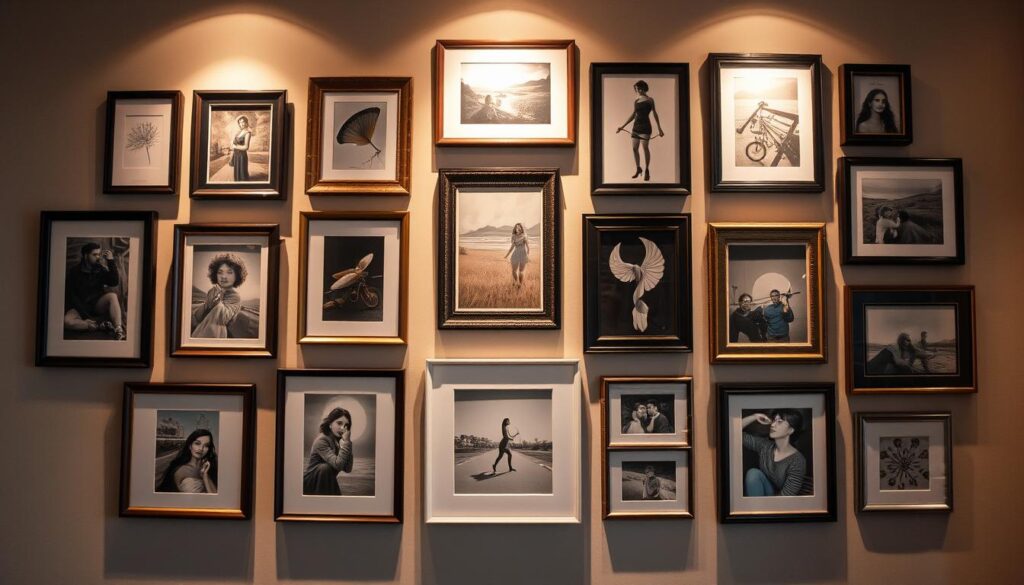
Professional Hanging Techniques for DIYers
To achieve a professional look, start by hanging the center piece and work your way outwards. Use a consistent spacing pattern to maintain visual harmony. For a more dynamic display, consider varying the spacing between frames.
Lighting Considerations for Your Gallery Display
Lighting can dramatically impact the appearance of your gallery wall. Consider both natural and artificial lighting options to showcase your curated pieces effectively.
Natural Light Interaction
Position your gallery wall to take advantage of natural light, if possible. Be mindful of how sunlight affects the colors and textures of your displayed items over time.
Artificial Lighting Options
For areas with limited natural light, or to highlight specific pieces, use spotlights or picture lights. LED lights are a good choice as they emit minimal heat, reducing the risk of damage to your artwork.
By following these tips, you can create a gallery wall that not only tells your story but also becomes a stunning focal point in your home. Remember, the key to a successful gallery wall is patience and a clear vision.
Conclusion: Your Wall, Your Story
Crafting a gallery wall is a personal expression of your story, and with the right approach, it can become a beautiful and meaningful part of your home decor. By incorporating personalized gallery wall decor, you can transform a simple wall into a narrative that reflects your unique experiences and style.
The art of storytelling through gallery walls lies in curating items that hold sentimental value and arranging them in a way that creates visual flow. Whether you’re drawn to unique gallery wall layouts or traditional designs, the key is to balance uniformity and variety to create a visually appealing display.
As you bring your gallery wall to life, you’ll discover that it’s not just a collection of frames and artwork – it’s a reflection of your personality and experiences. By applying the tips and techniques outlined in this article, you can create a galleries display that tells your story and adds a touch of warmth to your home.

